Don’t make your readers’ eyes glaze over
“Great clots of numbers dropped into a story with a steam shovel create a wall of abstraction.”
— William Blundell, author, The Art and Craft of Feature Writing

Don’t create a wall of abstraction. Reduce statistical clutter, increase readability and make numbers more understandable. Here’s how:
1. Use good numbers.
Get the number right, and get the right numbers.
Some 72% of companies have at least one graphical distortion in their annual reports, says Jimmy Locklear, executive vice president, Phelan Annual Reports Inc.
Make sure yours is among the other 28%.
“Your presentation will stand or fall on the quality, relevance and integrity of your content,” writes Edward Tufte, “the da Vinci of data.”
“If your numbers are boring, it’s too late. If your images aren’t relevant, putting them in four-color won’t help. Design can never rescue failed content. The best design can do is not screw up good content.”
2. Make your point.
“Few members of our audience turn to The Oregonian because they’re craving a good story problem.”
— Jack Hart, managing editor, The Oregonian
What’s the bottom line in this paragraph?
Who knows? The writer reported the data, but didn’t explain what the data meant.
“Not everything that can be counted counts, and not everything that counts can be counted.”
— Albert Einstein, genius
I know, I know, you dug up all these numbers, and now you want to use them. But just because you know the data doesn’t mean your readers must, too. If you focus on what you want your readers to take away from the data, you may find that you can make your point with far fewer numbers.
Ask, “Which of these numbers really explains the story to our readers?” Then dump the rest.
3. Use no more than three numbers per paragraph.
“Numbers bog down the text. Loading a story up with numbers almost guarantees low readership.”
— Jack Hart, managing editor, The Oregonian
Paragraphs packed with numbers just make your readers’ eyes glaze over. They look hard to read, so your audience members may decide to tune out before they even attempt the text. This paragraph, for instance, has six numbers:
Limit yourself to two or three numbers per paragraph. Count toward your total:
- Dates
- Times
- Spelled-out numbers like “two”
4. Communicate numbers visually.
If a picture is worth 1,000 words, then a graph is worth a million numbers.
To cut clutter, take some of your numbers out of the paragraph and place them into a simple table:
30-year house mortgage |
||
Interest rate |
5.5% | 7.5% |
Monthly mortgage payment |
$1,419 | $1,748 |
5. Choose the right kind of chart.
Bars, pies or lines? The right chart depends on the information you’re conveying. Use a:
- Bar chart to show how each piece relates to the others
- Pie chart to show how each piece relates to the other and to the whole
- Vertical bar chart to fix several things in one moment in time
- Line chart to show trends
- Table to compare two or more items by two or more characteristics
Choose bars and pies. Bar graphs and pie charts are both more effective than line charts at helping readers understand statistical data.
6. Communicate with charts.
Make sure your chart says what you mean.
- Cut your pie into big pieces. Pie charts start getting confusing when you have more than five “slices,” Locklear says. “Slices become too thin, and it becomes difficult to differentiate and compare values.”
- Position time values from left to right. Some charts start with the most recent year to highlight it. But because Westerners read from left to right, that can confuse readers. Instead, place the earliest year at the left, Locklear advises, the most recent year at the right.
- Keep it simple. A chart should make one point clearly. You say you have more than one idea? Then you need more than one chart.
- Keep it clear. In a table with more than five rows of columns, use screens to delineate each row.
7. Present your chart.
Transform your chart into a free-standing data package.
Write a headline. A real one, with a hook. Not just a label.
Write a caption. People are more likely to read it than the text of your article. What do you want them to take away from this chart?
Rising interest rates make homes less affordable
30-year house mortgage |
||
Interest rate |
5.5% | 7.5% |
Monthly mortgage payment |
$1,419 | $1,748 |
It adds up: A small increase in interest rates can make a big difference in your monthly budget.
8. Spread your stats around.
“Numbers bog down the text. Loading a story up with numbers almost guarantees low readership.”
— Jack Hart, managing editor, The Oregonian
Pace yourself. Limit yourself to two paragraphs containing numbers in a row. You don’t need to cram all the facts and figures into one section of the story.
9. Round numbers off.
Unless your readers are statisticians, it’s rare that they’ll need six decimals of precision (or even one!) in the numbers you report.
- Avoid: 64.36752%
- Better: 64%
- Even better: Almost two-thirds
- Best: Two out of three
10. Use words.
Substitute words for numbers whenever you can:
- “One in five” gives a better picture than “20%.”
- “Nearly doubled” means more than “a 97%increase.”
- “Two-thirds” is clearer than “67%.”
11. Do use precision to make a point.
If your point is fragility, go ahead and use the precise number. That’s what the late-great Kansas City Star columnist C.W. Gusewelle did to help readers understand how delicate and vulnerable monarch butterflies are as they migrate south for the winter:
Consulting the literature, I find that the average weight of an adult monarch may be expressed as 0.0176 of an ounce, about the same as a good-sized snowflake.
The same thing is true if your point is specificity. Some of my clients in the telecom industry use “five nines” — or 99.999%— to express the accuracy of their equipment.
“Nearly 100%,” obviously, doesn’t say the same thing.
Learn more about writing statistics.
- What’s the latest U.S. numeracy rate? Here’s why your readers struggle to understand your numbers.
- How to write statistics right: The fanciest chart can’t overcome a bad data set or standard deviation.
- What’s the effect of statistics in persuasive writing? Reframe the data to improve decision-making.

Leave a Reply